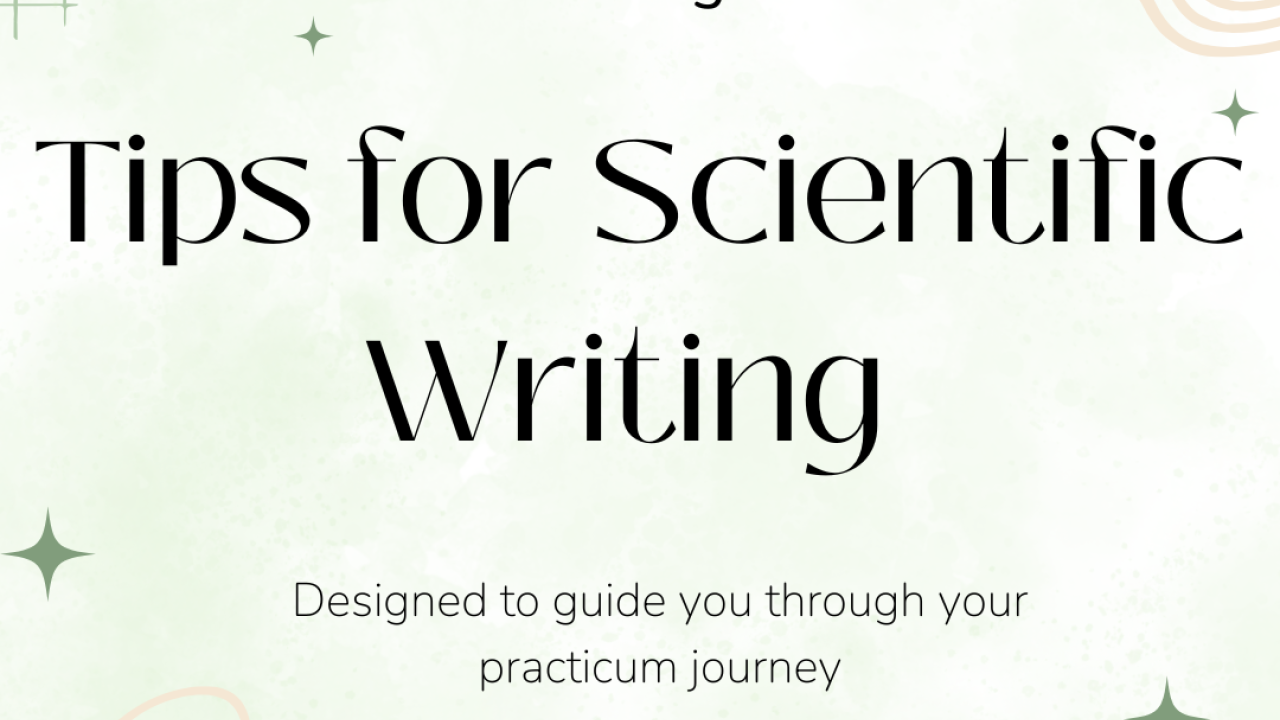
Tips for Scientific Writing
Designed to guide you through your practicum journey
Scientific writing, whether for your practicum project or a term paper, can feel like a daunting process. However, it can also be an incredibly eye-opening and beneficial experience that helps you grow as a student, scientist, and writer. This guide is designed for students that aren’t sure where to start with their scientific writing process, or for those that haven’t yet begun their practicum and want to understand what might be helpful to know before they begin.
Beginning the research process
If you are writing about your own research, before you start writing, familiarize yourself with your data and notes. Get an idea of what questions you want to answer in your paper, and what type of information would be helpful for the reader to understand before delving into your paper.
Research resources
Using databases is a great way to get started with your writing process. Using your UC Davis login, you can access a wide variety of databases, including those listed on the UC Davis library website, and more.
- UC Davis Library A-Z Databases
- This link will take you to a search tool so you can explore all of the databases the UC Davis library has to offer. This can be a good place to start if you have a specific type of database/topic in mind, and want to find the right database for your research needs.
- UC Davis Library Research Guides
- The library research guides are organized into specific classes and subject areas, making it easy to find a starting place if you’re unsure how to begin. For example, if you are researching something about climate change, you might try clicking on the ‘Atmospheric Science’ research guide to begin.
- Annual Reviews
- Annual Reviews is a great place to go to learn more about your topic of interest. Annual Reviews contains a plethora of articles that “transfer expert knowledge synthesized from the expanding corpus of scientific literature to scholars and society”, which helps the reader understand what is currently understood about a specific topic, what aspects of research on that topic is supported vs controversial, and outlines the topic’s practical applications and significance. I personally used this database heavily in my research process for my practicum report. I was writing about malaria, and wanted to first understand as much background information as I could so that I was prepared to create a practicum project that asked relevant questions and contained pertinent background information.
- Google Scholar
- Google Scholar is an excellent, accessible tool for scientific writing. This program will show you articles from various types of databases, which can be helpful if you’re not sure if you have enough background information on your topic yet to hone down your search within a single database. You can use the filters on Google Scholar to only show recent articles, only review articles, and sort by date or relevance. I found this tool to be incredibly helpful in my practicum writing process, because it helped me identify multiple perspectives of my topic since Google Scholar helped me broaden my search to look within a wide variety of databases.
- Encyclopedia Britannica
- Encyclopedia Britannica can be a helpful resource to help you begin your research process. While this is an encyclopedia rather than a database of peer-reviewed articles, it can be helpful to give you background information, define unfamiliar terms, and figure out what kind of information your reader (or you) should know before delving into the heart of your research paper.
As you go through your research process, make sure that as you sift through articles and databases, that you are searching for peer reviewed articles. An article that is peer reviewed has gone through a thorough review process by other experts in the same field of research, and helps validate the quality and reliability of the article. These types of articles are the kind that should make up the bulk of your citations to ensure that your research paper is comprised of reliable, accurate information.
How to read scientific articles
Before beginning to read scientific articles, it is important to understand how to read them. Reading every single article all the way through as you research is incredibly time-consuming, and will make it difficult to review a wide variety of research papers within your time constraints.
The first step to understanding how to read a scientific article is understanding what each section of the article means. Scientific articles will usually be comprised of an abstract, introduction, methods, results, discussion, conclusion, and references.
- The abstract will give you a brief synopsis of the study, and usually contains a sentence or two that represents each section of the article. Starting off by reading the abstract of an article will help you decide whether that article will be useful to include in your paper.
- The introduction/background contains all the background information that the authors want the reader to be familiar with before engaging with the rest of the article. This section also will outline what questions the authors will tackle in the rest of the article. It can be helpful to skim this section if you have determined that an article might be useful for your research paper; a lot of this information can be helpful to identify what types of background information you should include in your own introduction section.
- The methods section outlines the actual process the researchers went through to carry out their experiment. The methods section is helpful if you want to replicate the experiment yourself, or if you want to learn how to write your own methods section. Otherwise, you can skim or skip this section if you are just looking for useful pieces of information to cite in your own paper.
- The results section will contain data in the form of graphs, figures, tables, and pictures. This section will only display the data and explain any necessary information for reading each figure. This section will not analyze the data; so, if you find a figure that you are interested in incorporating in your own research paper, you will also need to read through the discussion section to understand its significance.
- The discussion is the authors’ analysis and interpretation of the results. This is a helpful section to read if you want to use a figure from a particular article and want to know its significance, or it can be a good section to read to collect more citable information for your own report.
- The conclusion section can sometimes be helpful, because reading the authors’ concluding statements can help you understand the main takeaways and broader implications of the research.
- The references section is also helpful throughout your research process. If you find an article that aligns heavily with your own paper, looking through their references section can help you find more articles that could be useful to cite in your own paper.
In summary, if you skim an abstract and think the article might be useful in your own research process, give the results and discussion sections a more thorough read-through to glean any important information that can further inform or support your own research.
Note-taking tips
Personally, I struggled with figuring out how to properly take notes as I researched. I found myself writing down entire lines of text word-for-word, just because I thought the information might be useful later as I started writing my paper. Throughout my experience writing term papers and my practicum, I found that the method that worked best for me was to start by gathering research articles and skimming through just the abstract to see if it could be used in my paper. Then, I created a document where I kept track of each paper, and put a short sentence or phrase underneath the link to remind me why I thought the paper might be helpful. After I gathered a variety of articles, I started skimming through the discussions and references of each one to see if there were any pieces of information that I could use, or any articles that could further my understanding. Once I felt like I had gathered enough information, I began creating my outline. Read more about the outline process in the next sections.
Writing your research paper
Depending on whether you’re writing about your own research or doing a literature review on a particular topic, there are different layouts that work best for each type of paper. For your practicum, it is best to begin by discussing with your practicum mentor what layout/format they think would be best for your practicum report.
Whether you’re writing about your own research or synthesizing a collection of research, it is always helpful to begin your writing process with an outline. For a practicum project, you will likely have a typical abstract-introduction-methods-discussion-conclusion flow for your paper. Within those main headings, you can fit in subheadings that can help organize your paper. Start by writing out your main headings and subheadings. Then, you can start organizing pieces of research into your newly organized outline. As you fill in your sections, you can start identifying the areas where you need to include more information, and you can quickly find and add that information directly into your paper, rather than just adding it to your notes document.
If you’re feeling stuck, sometimes handwriting your thoughts on paper can be helpful. If you aren’t sure how to organize your paper or aren’t sure how to write each section, you can look up peer reviewed articles on a similar topic and take note of how those articles are written. Lastly, you can always look to your practicum mentor for guidance.
Remember that this process takes time; be patient with yourself and set small, achievable goals throughout the process to help you maintain progress and make the process feel less daunting.
Citations and References Tips
Keeping track of your citations and references throughout the research and writing process can be difficult, so using a software like Zotero or EndNote (Zotero is free, Endnote has paid subscriptions) is incredibly helpful. These programs will keep a library of your citations for you and are able to generate your references section in the format of your choosing based on the articles you cite in your paper.
Once you download a program, you have to manually add it as an add-on to your Microsoft word or google docs account. Once it’s added, you will see it pop up at the top of your document in the menu bar at the top. If you need more assistance downloading or using either of these programs, peer advisor Emily can help you! Email gdb-advise@ucdavis.edu and ask for Emily. Put ‘Tips for Scientific Writing blog, using Zotero help’ in the subject line.
Formatting and typography
Displaying your research visually in your paper is just as important as the content itself. Learning about typography and formatting is immensely helpful for making sure your paper is visually easy to read, your sections are clearly defined, and that even just by first glance, your reader will be excited to read your work.
To learn more about what types of formatting and typography will be useful for your paper, look at the resources listed on: Butterick's Practical Typography
We hope this guide is helpful on your practicum writing journey! If you need more assistance/tips or have questions about anything in this blog, please email us at gdb-advise@ucdavis.edu. Happy writing!
